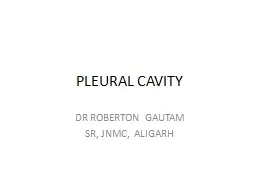

SR JNMC ALIGARH Pleural cavity The thoracic cavity is divided into three compartments right and left lateral compartments and middle compartment Each lateral compartment is occupied by ID: 913289
Download Presentation The PPT/PDF document "PLEURAL CAVITY DR ROBERTON GAUTAM" is the property of its rightful owner. Permission is granted to download and print the materials on this web site for personal, non-commercial use only, and to display it on your personal computer provided you do not modify the materials and that you retain all copyright notices contained in the materials. By downloading content from our website, you accept the terms of this agreement.
Slide1
PLEURAL CAVITY
DR ROBERTON GAUTAM
SR, JNMC, ALIGARH
Slide2Pleural cavity
The thoracic cavity is divided into three compartments
:
right and left lateral compartments and middle compartment. Each lateral compartment is occupied by a lung enclosed in the serous sac called pleural cavity. The mass of tissues and organs occupying the middle compartment form a mobile septum—mediastinum that completely separates the two pleural cavities.
Slide3PLEURAL CAVITIES
Each
lung is invested by and enclosed in a serous sac
which consists of two continuous serous membranes—the visceral pleura and parietal pleura.The visceral pleura invests all the surfaces of the lung forming its shiny outer surface, whereas the parietal pleura lines the pulmonary cavity (i.e., thoracic wall and mediastinum).The space between the visceral and parietal pleura is called pleural cavity.
The
pleural
cavity is normally filled with a thin film of
tissue fluid
, which lubricates the adjoining surfaces of the
pleura and
allows them to move on each other without friction.
The two layers become continuous with each other
by means
of a
cuff of pleura, which surrounds the root of
the
lung
consisting of structures entering and leaving the lung
at the
hilum
of the lung, such as principal bronchi
and
pulmonary vessels
.
Slide4Slide5PLEURA
The
pleura-like peritoneum is a serous membrane lined
by flattened epithelium (mesothelium). The lining epithelium secretes a watery lubricant—the serous fluid.LAYERS OF THE PLEURAThe pleura consist of two layers: (a) visceral pleura and (b) parietal pleura. The moistened space between the two layers is called pleural cavity (vide supra).Parietal pleura, according to the surface, which it lines, covers or the region in which it
lies,
is
divided into
the following four parts
:
1. Costal pleura.
2. Diaphragmatic pleura.
3.
Mediastinal
pleura.
4. Cervical pleura.
Slide6Slide7Pulmonary ligament
It is the Pleura around the root of lung extends down as a fold.
Extends down till diaphragm.
Contains : loose areolar tissue and lymphatics Functions:
Dead space into which pulmonary veins can expand.
Allows descent of root of lung with descent of diaphragm during inspiration
.
Slide8Lines of pleural reflection.
Slide9RECESSES OF THE PLEURA
in
areas of pleural reflection on to
the diaphragm and mediastinum, the space between the parietal and visceral pleura is greatly expanded and are called pleural recesses. They are essential for lung expansion during deep inspiration. The recesses of pleura are as follows: 1. Costodiaphragmatic
recesses (right and left).
2
.
Costomediastinal
recesses (right and left).
three
more small
recesses
Right
and left
retroesophageal
recesses
Infracardiac
recess
Slide10Costodiaphragmatic
recess
: It is located inferiorly between the costal and diaphragmatic pleurae. Vertically it measures about 5 cm and lies opposite the 8th–10th ribs along the
midaxillary lineCostomediastinal recess : It is located anteriorly between the costal and mediastinal pleurae and lies between sternum and costal cartilages. The left costomediastinal recess is large due to the presence of cardiac notch in the left lung.
Slide11Radiological appearance of pleural effusion
the
costodiaphragmatic
angle is obliterated (widening of the angle). It is seen as radiopaque shadow with a fluid line in X-ray chest. Sites of extension of pleura beyond the thoracic cage:There are five sites, where pleura extends beyond the thoracic cage : 1. On either side in the root of the neck (as domes of pleura). 2
. In the right
xiphisternal
angle.
3
. On either side in the
costovertebral
angle.
The pleura can be punctured inadvertently at these
sites during
surgical procedures.
Slide12NERVE SUPPLY OF THE PLEURA
The
parietal pleura
is supplied by the somatic nerves and is sensitive to pain.Costal and peripheral part of the diaphragmatic pleura is supplied by the intercostal nerves. Mediastinal and central part of the diaphragmatic pleura is supplied by the phrenic nerve.The visceral pleura
is
supplied by
the autonomic
(sympathetic) nerves (T2–T5) and is
insensitive to
pain
.
Referred pain of pleura
: The pain from
central
diaphragmatic
pleura and
mediastinal
pleura is referred
to the
neck or shoulder through
phrenic
nerves (C3, C4,
and C5)
Slide13Differences between the parietal and visceral pleurae
Parietal pleura
Lines
the thoracic wall and mediastinumDevelops from the somatopleuric mesodermInnervated by the somatic nervesSensitive to painBlood supply and lymphatic drainage is same as that of thoracic
wall
Visceral
pleura
Lines the surface of the lung
Develops from the
splanchnopleuric
mesoderm
Innervated by the autonomic nerves
Insensitive to pain
Blood supply and lymphatic drainage is same as that of the lung
Slide14BLOOD SUPPLY AND LYMPHATIC DRAINAGE OF THE PLEURA
Blood
supply of parietal pleura is same as that of
the thoracic wall and blood supply of the visceral (pulmonary) pleura is same as that of the lung.
Slide15CLINICAL
Pleurisy or
pleuritis
: It is the inflammation of the parietal pleura. Clinically it presents as pain.The collection of serous fluid, air, blood, and pus in the pleural cavity is termed hydrothorax (pleural effusion) pneumothorax, hemothorax, and pyothorax (empyema), respectively.Pleural effusion: Normally the pleural cavity contains
only 5–10 ml of clear fluid, which lubricates
the pleural
surfaces to allow their smooth movements
without friction.
Slide16Thoracocentesis
/pleural tab: It is a procedure by
which
an excess fluid is aspirated from the pleural cavity. It is performed with the patient in sitting position. Usually the needle is inserted in the 6th intercostal space in the midaxillary line.
Slide17Pneumothorax
:
Accumulation of air in the pleural cavity is called pneumothorax.- Spontaneous pneumothoraxOpen pneumothoraxTension pneumothorax
Slide18